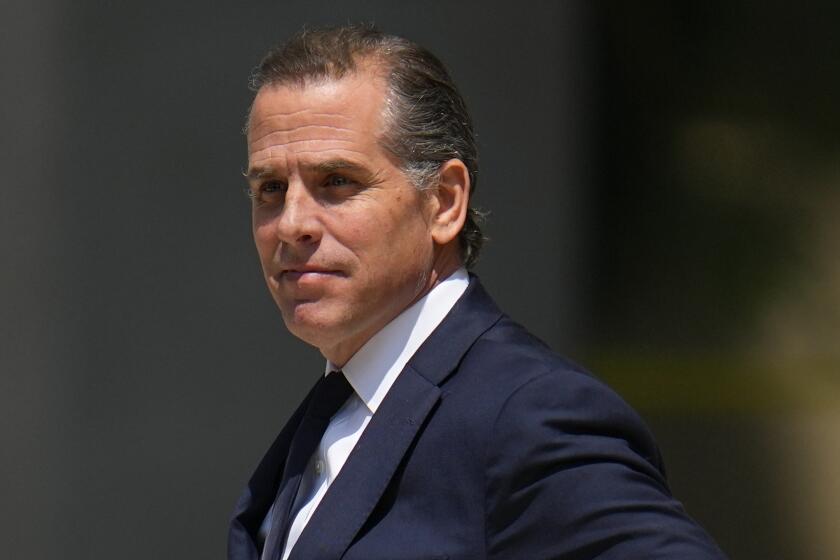The Vanishing
- Share via
The “German miracle” was the rise of West Germany after the war, like a phoenix from the ashes of defeat. The combination of Economics Minister Ludwig Erhard’s stubborn espousal of the market economy and federal Chancellor Konrad Adenauer’s political skills in wresting sovereignty from the Allied occupation powers, while making sure that their domestic base remained strong, was miraculous indeed. Within five years of the foundation of the German Federal Republic, the rump country had become an economic powerhouse and a political force to be reckoned with, indeed a member of NATO.
The second German miracle happened 40 years later. It was the unification of powerful West Germany with the collapsing German Democratic Republic in the east. The process is the most poignant element of the West’s victory in the Cold War. How was it possible?
Charles S. Maier, the distinguished Harvard historian who witnessed events as they unfolded in Berlin in 1989 and 1990, has now answered the most fascinating question concerning the process of unification: How did the dissolution of the GDR come about? Some of us remember what happened during that summer of 1989 all over hitherto Communist Europe. We have not forgotten the pictures of East German holiday-makers in West German embassy compounds in Budapest and Prague, who were distinctly unwilling to return to their allegedly prosperous country. We remember how Lech Walesa’s Solidarity turned first into a round table, then into a non-Communist government in Poland. Then there are the television images of President Nicolae Ceausescuof Romania suddenly realizing that the crowd in front of him was hostile, not docile. Why did all this happen? What had changed?
There was Mikhail Gorbachev, of course. Once he had introduced glasnost, a certain freedom of speech, people said what they wanted, and this was not, in the terms of the old regimes, politically correct. There was the indomitable desire to travel; mobility is practical freedom. Then there was the decline of the economies, at a time in which television--unable to respect any borders--spread the news of economic revival in the West. Beyond that, every Communist country had its own story to tell, skeletons falling out of many cupboards, new heroes like Vaclav Havel emerging, crowds chanting unheard-of slogans--”We are the people,” which, in Leipzig, soon turned into demands for German unity: “We are one people.”
Maier traces the dissolution of the GDR both in minute detail and with the wisdom acquired from long experience with the subject. His answer to the question of why it happened is clear: “Communism self-destructed.” It had become a hollow edifice with an ideology believed by few and with a nomenklatura of rulers liked by nobody. East Germans had created their own “niche society” of private pleasures tolerated by a regime that failed to recognize that these involved detachment rather than support. International public opinion increasingly turned against Communist regimes everywhere, not the least in East Germany. The leaders became jittery.
Then the economies of Communist countries began to falter. In the most fascinating analytical chapter of his book, Maier raises, and answers, the critical question, “Was socialism doomed from the outset, or were there later fateful turning points?”
His answer, for the GDR, is that socialism might have been viable if it had adopted market elements in the 1960s (in other words, if it had ceased to be socialist). The stubborn defense of principle, however, was bound to lead the German Democratic Republic into a spiraling debt that, by the time of collapse, required more than the country’s total export earnings to service. Dependence on the Soviet Union for oil, the simultaneous pursuit of a wasteful investment program in computers and a policy of rising consumption--which in effect had to be financed by West Germany--aggravated the dilemma to the point that there was no way out. Socialist economies were always precarious, but self-imposed constraints and mistaken policies made them unable to respond to the challenges of the 1970s. From then on, collapse was only a matter of time.
The question remains why we in the West did not realize the imminence of this collapse. Why did 1989 come as a surprise after all? I am not sure Maier has any more of an answer than the rest of us. One cannot rule out the possibility that the world will make the same mistake again--with Cuba? with China?--of underestimating the pressures that destroy seemingly stable regimes.
Maier tells the story of the East German revolution with his characteristic blend of well-documented historiography and shrewd analysis. If his book has any weakness, it is in the assessment of the international context of German events, though this is by no means ignored. Seen from within, the dissolution of the GDR was a very German event, “more a process of bureaucratic decomposition than coherent challenge.” Irritated workers and earnest Protestants joined forces in the demand for consumer choice, plus travel opportunities. The regime began to wobble in the summer and autumn of 1989. “Life,” Gorbachev said famously, “punishes those who come late.” (He said “life” and not, as Maier suggests, “history,” because he was even then more a Bergsonian existentialist than a Marxist.) Change was in the air.
It happened, by that accident, that the Berlin Wall opened on Nov. 9, 1989, a half-understood Politburo decision implemented in as much confusion as intent. Suddenly people were free to leave, and they did so by the thousands. Yet the revolution took a long time to unfold, nearly a year, until the Day of German Unity, Oct. 3, 1990. In the meantime there had been two rounds of elections, three successive East German governments, negotiations between the two Germanies and of the Germanies with the fading occupation powers. For a surprisingly long time, people were looking for a “third way”--two third ways, to be exact: one domestically (“market socialism”), one in the configuration of the Germanies (“confederation”). In the end, the conclusion was less ambiguous. Maier calls it, a little unkindly but in many respects correctly, an Anschluss: East Germany was absorbed into the Federal Republic.
*
The story does not end here. Maier speaks of “Anschluss and Melancholy.” Perhaps. What actually happened was that the forces of unity were irresistible during that fateful year, 1989-’90. West German Chancellor Helmut Kohl recognized their strength and became their champion when many others voiced doubts. Among them were Western politicians like Francois Mitterrand, Margaret Thatcher and German intellectuals who had come to love their cozy province. But the process of which Willy Brandt had said “now what belongs together is growing together” turned out to be much more complicated. Political absorption did not, and could not, wipe out the divergent experiences of people in the two states that had, after all, been separate for 40 years.
Maier is optimistic about the future. He detects already a “nuanced set of shared attitudes” on which East and West Germans are converging. I am not so sure. For one thing, economist Albert Hirschman’s brilliant analysis of “exit” and “voice” in relation to East Germany deserves more than a passing reference.
East Germans are still leaving, and they no longer have to emigrate to go to former West German places where hard work pays fairly quickly and, indeed, where work is available. Sometimes I see the former East Germany as something like the Ireland of old (not, to be sure, the flourishing Ireland of the last decade): a little slower than the rest, a little more human even, given to melancholy and whiskey in equal proportions, sad about those who leave yet sure that they will return one day and perhaps with some money. . . . Culturally, it does not take much knowledge to detect the old border in Germany, although the wall and the barbed wire have luckily gone for good.
In any case, the story is worth telling and pondering. Maier is not a great stylist, but he has a rare talent to make sense of diverse and multifarious facts. His book will surely find a lasting place among the attempts to come to terms with the revolution of 1989. It is also a supreme example of calm critical appreciation of a country that still stirs the emotions of many.
More to Read
Sign up for Essential California
The most important California stories and recommendations in your inbox every morning.
You may occasionally receive promotional content from the Los Angeles Times.










